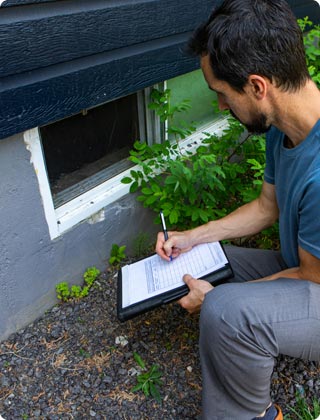
Crawl Space Inspection Checklist
Many homeowners overlook their crawl spaces, but a thorough crawl space inspection checklist is essential for maintaining a healthy and safe home environment. By following a checklist, you can spot hidden issues before they turn into expensive problems. This kind of organized process helps both current homeowners and future buyers uncover concerns early, protecting their investment and ensuring every part of their house is in good shape.
In this guide, we'll break down actionable steps, field-tested crawl space tips, and reliable checklist advice direct from O2 Mold Testing's years of expertise. Whether you're trying to protect your home's value or guard against mold, pests, and structural risk, our expert crawl space checklist will help you do it right.
Why Crawl Space Inspections Matter
Your crawl space is that shallow section between your home's ground floor and the earth. It's usually just tall enough for someone to crawl through - hence the name. Crawl spaces make it easier to access plumbing, wiring, and other structural elements underneath your house. While it's out of sight, its upkeep is essential for indoor air quality, structural safety, and overall property value.
Because crawl spaces are often damp, dark, and poorly ventilated, they can become breeding grounds for slow-building threats:
- Mold and Mildew: Crawl spaces are highly susceptible to mold growth due to excess moisture. This is often confirmed during a crawl space mold inspection and can lead to respiratory issues or aggravate allergies.
- Water Problems: Standing water or persistent dampness promotes rot and weakens foundational supports.
- Pest Infestation: Rodents, termites, and insects love to nest in these hidden areas, chewing through insulation and wires.
- Structural Issues: Rotting wood, shifting soil, and cracks in the foundation may all start in neglected crawl spaces.
Routine crawl space maintenance is crucial. It helps you prevent expensive emergencies, protect your property, and keep your living environment safe and healthy. The EPA notes that damp crawl spaces can worsen indoor air pollution. The International Association of Certified Home Inspectors also highlights that regular crawl space inspections can stop small issues from turning into major structural failures.
The Expert Crawl Space Inspection Checklist
A well-organized crawl space inspection checklist is your best tool for a safe home. Use the list below during each inspection, and revisit it regularly as part of your crawl space maintenance plan.
1. Entrance/Access Door
What to look for: Check that the door or hatch to your crawl space seals tightly, is undamaged, and can be opened without trouble.
Why it matters: A tight entrance helps block pests and moisture from sneaking inside.
Crawl space tips: Add weather stripping or replace warped doors for extra defense.
2. Vapor Barriers and Insulation
What to look for: Inspect for vapor barriers, like thick polyethylene sheets, laid securely on the ground. Insulation should be firmly attached, without sagging or signs of water damage.
Why it matters: Vapor barriers and good insulation stop ground moisture from seeping up into your living areas, keeping air drier and healthier.
Crawl space tips: If you spot torn plastic or drooping insulation, repair or replace it promptly. InterNACHI advises checking insulation yearly.
3. Signs of Moisture or Standing Water
What to look for: Look for puddles, wet soil, muddy spots, or excessive humidity levels.
Why it matters: Persistent moisture erodes wood and encourages mold or mildew. High humidity is a warning sign for crawl space mold inspection.
Crawl space tips: Keep a hygrometer in your crawl space to monitor dampness regularly.
4. Visible Signs of Mold or Mildew
What to look for: Observe any unusual spots, fuzzy growths in black, green, or yellow, and detect musty odors.
Why it matters: Mold, if left unchecked, damages wood and insulation, and increases health risks for home occupants.
Crawl space tips: If you spot small patches, wear a mask and gloves to clean with a mold cleaner, but large infestations require professional help.
5. Foundation Walls and Structural Supports
What to look for: Scan for cracks, bowing, crumbling concrete, soft wood, or shifting piers.
Why it matters: Foundation issues can lead to major repairs if ignored and can affect your entire home's stability.
Crawl space tips: Even hairline cracks should be monitored and filled with appropriate sealant. Extensive problems mean it's time to call an expert.
6. HVAC, Plumbing, and Electrical Systems
What to look for: Watch closely for leaks, rust, condensation on pipes, and damaged or exposed wiring.
Why it matters: Water leaks can cause rot and further moisture issues, while faulty wiring can present fire hazards.
Crawl space tips: Wrap exposed pipes and check for any changes in condensation or rust between inspections.
7. Pest Infestation Evidence
What to look for: Find rodent droppings, insect nests, chewed insulation, or tunnels in wood.
Why it matters: Pests erode insulation, damage structure, and can spread disease.
Crawl space tips: Set traps only for minor issues; major infestations require exterminator services.
8. General Cleanliness and Debris
What to look for: Remove any trash, wood scraps, or construction debris blocking air vents or lying around.
Why it matters: Debris attracts pests and can block ventilation, increasing moisture.
Crawl space tips: Regular sweeping and an organized space prevent these problems before they start.
Mold Inspection in Crawl Spaces
Crawl space mold inspection requires a sharp eye for both obvious and hidden mold threats. Here's how to do it effectively:
- Visual check: Mold can appear as black, green, white, yellow, or even brown splotches or fuzz. Focus on wooden supports, insulation, and HVAC lines, as these are prime locations for growth.
- Odor test: A musty or earthy smell is a classic indicator, even if you can't immediately see a mold colony.
- Risks of mold: Exposure to mold can worsen asthma, trigger allergies, and cause breathing problems, especially in young kids and seniors (CDC). Over time, mold destroys insulation, damages wood framing, and lowers your home's air quality.
If your crawl space mold inspection finds a persistent musty odor, visible clusters covering large areas, or you spot moisture that never dries out, it's time for crawl space expert advice. O2 Mold Testing recommends professional mold assessment if you suspect widespread growth or if past moisture problems keep returning. As a key crawl space checklist step, professional inspection ensures safe, effective remediation and protects both your family and property value.
Ongoing Crawl Space Maintenance Tips
Routine upkeep helps prevent most crawl space problems before they escalate. Here are the best crawl space maintenance steps and crawl space tips every homeowner should follow:
- Conduct seasonal checks: After heavy rains or melting snow, check crawl spaces for new water entry.
- Ventilation and humidity: Run dehumidifiers or install ventilation fans if you notice the space feels damp or humid. Target humidity under 60% to prevent mold.
- Keep insulation and vapor barriers healthy: Replace moisture-damaged insulation or torn vapor barriers quickly.
- Watch plumbing and HVAC lines: Look for signs of new rust, leaks, or condensation on pipes.
- Minimize clutter: Clean up loose debris, fallen insulation, or any construction waste regularly.
DIY-Capable Tasks:
- Visual checks for leaks, mold, or pests
- Removing debris and keeping vents clear
- Monitoring air moisture using a simple meter
When to Hire Professionals:
- Water damage that does not clear up with basic fixes
- Widespread mold growth
- Obvious shifting or bowing of support beams
- Persistent pest infestations
Regular crawl space maintenance keeps your investment protected and stops big repairs before they start. The Department of Energy notes that well-maintained crawl spaces boost comfort and safety. Our techs also recommend weighing the costs of professional repairs against ongoing neglect, as issues only become more expensive over time.
Crawl Space Expert Advice: Pro Tips from O2 Mold Testing
Learning from the pros can save you time, money, and stress. Here are some crawl space expert advice points to keep in mind:
- Do not ignore small leaks or new cracks: Even 'minor' issues in a crawl space can quickly escalate, undermining your home's structure or leading to costly mold remediation.
- Check vapor barriers religiously: Skipping regular checks is a top crawl space maintenance mistake. Even a small tear can let in damaging moisture that leads to mold or rot.
- Avoid using the crawl space for storage: Items stored here can block vents, attract pests, and hide potential problems from your crawl space inspection.
If you are ever in doubt - whether you notice new cracks, sustained dampness, or evidence of rodents - it is wise to call for crawl space expert advice. Professionals like O2 Mold Testing use specialized equipment for detailed crawl space mold inspection and know precisely where trouble tends to lurk. An expert crawl space inspection does not just find immediate issues; it often reveals risks you would never spot on your own, such as hidden leaks or early signs of structural settling.
A professional inspection is particularly critical during real estate purchases, after major storms, or if your home has a history of water or pest issues. O2 Mold Testing combines expert knowledge, industry-grade equipment, and years of hands-on experience to provide peace of mind and reliable solutions for homeowners. No other part of routine home care delivers as much long-term value as a thorough and professional service.
The Value of a Crawl Space Inspection Checklist
Prioritizing regular crawl space inspections and making use of a checklist delivers more than peace of mind - it is a proactive way to preserve your property's safety, value, and comfort. By following expert tips, using professional guidance, and staying consistent with crawl space maintenance, you can prevent the most common (and costly) home issues before they take root.
Remember the key crawl space tips shared above - such as checking for moisture, keeping insulation intact, managing pests, and trusting your nose for early signs of mold. With O2 Mold Testing's expert advice, you have a reliable partner in keeping your crawl space safe. If you have questions, spot new problems, or just want an expert crawl space mold inspection service, do not hesitate to contact us today.


